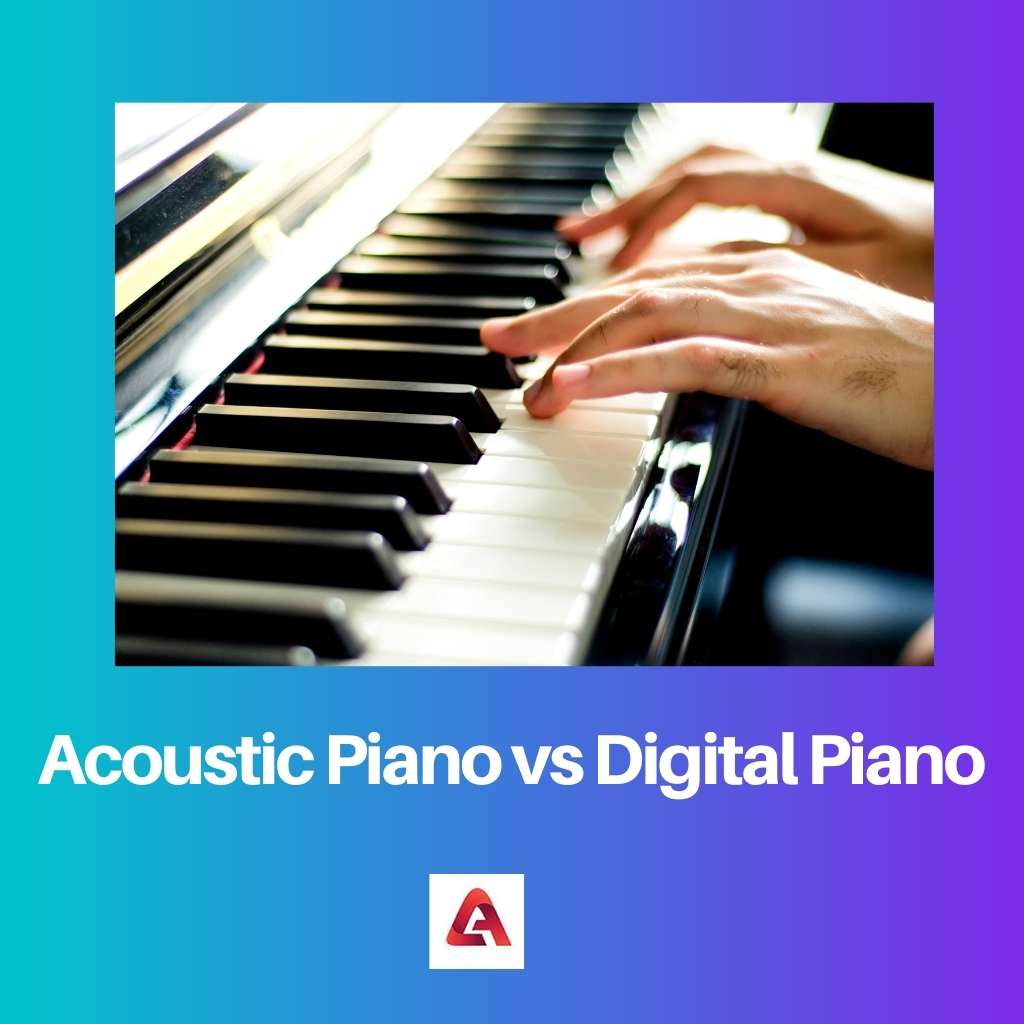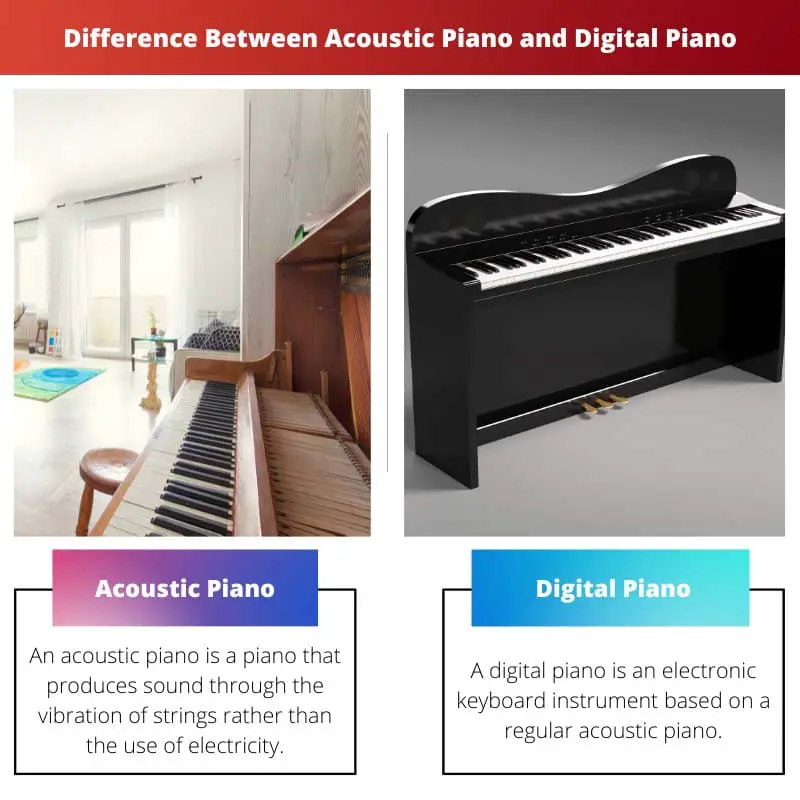Both the acoustic and electronic pianos serve their different purposes: to provide an exciting musical experience and the other as a cheaper alternative for practice. Both pianos are built to last longer, with the proper maintenance.
The acoustic piano has a longer learning curve; however, the digital piano lets you learn faster and requires significantly less effort to carry.
Regardless of which one you choose to purchase, you should be pleased with its ability to create beautiful music in any situation.
Key Takeaways
- Acoustic pianos use hammers and strings to produce sound, while digital pianos use sampled sounds electronically.
- Acoustic pianos have a richer and more complex sound than digital pianos.
- Digital pianos are more portable and require less maintenance than acoustic pianos.
Acoustic Piano vs Digital Piano
The difference between Acoustic Piano and Digital Piano is that the sound of an acoustic piano is produced by felt-covered hammers striking steel-wire strings.
In contrast, the sound of a digital piano is made by electronic speakers playing high-quality recordings taken from the best acoustic pianos.

Acoustic Piano is an instrument that is played by hammers striking strings. It is a stringed musical instrument with a hammer action; it originates from the harpsichord. This instrument is found in the piano, where it was invented.
The built-in speakers of a digital piano have better fidelity and clarity, making them ideal for practicing or performing in front of a larger audience.
It also helps that many models come with internal memory, so you can save your favorite settings and sound samples to the instrument itself.
Comparison Table
| Parameters of Comparison | Acoustic Piano | Digital Piano |
|---|---|---|
| Maintenance | Because humidity variations can affect the tune of an acoustic piano, it requires a high level of maintenance and it should be stored in a location where the temperature does not fluctuate. | A digital piano does not require high maintenance. |
| Space requirement | Acoustic pianos requires a large area. | A digital piano does not take up much room and is significantly smaller than an acoustic piano. |
| Weight difference | Acoustic Piano is heavier than a digital piano. | Digital pianos are lighter and can be easily moved and relocated. |
| Sound | Only a single sound is produced by an acoustic piano. | A digital piano provides you with a wide range of pianos and other instruments to choose from. |
| Digital devices | An Acoustic piano cannot be connected to an iPad or iPhone. | Digital pianos may be connected to an iPad or iPhone and used to practice with various apps. |
What is Acoustic Piano?
An acoustic piano is a piano that produces sound through the vibration of strings rather than the use of electricity.
Acoustic pianos are also known to have a warmer, more natural tone than their digitally sampled counterparts. They are much heavier than digital pianos and require tuning every year.
Tuning an acoustic piano is necessary as the tension in the strings slowly changes over time and with different humidity levels.
Most professional pianists keep a tuning hammer in their instrument case for emergency situations. They need to tune their instrument faster than they would be able to at home.
The hammer is used to knock some of the tension out of the strings, effectively lengthening them slightly. This adjustment brings the pitch of each string down, thus raising its tone by half a step.
The process is repeated until all of the notes are in proper tune with one another.
They produce sound when the hammers inside strike the strings. The hammers hit the tines connected to a jack at one end and a damper at the other.
Tines are available in a variety of materials, including brass and steel. The tines are then grouped into three to six clusters. One tine is securely strung in each group while the rest are loosely strung.

What is Digital Piano?
A digital piano is an electronic keyboard instrument based on a regular acoustic piano. Digital pianos sound precisely like a piano, and they look very much like acoustic pianos. However, the internal mechanism is totally different from an acoustic piano.
The main components of an acoustic piano are strings and hammers, which give the piano its characteristic sound. In contrast, the main features of a digital piano are the keyboard action, the amplifier, and the speakers.
The keyboard on a digital piano looks like a regular piano keyboard: it has white and black keys arranged in semitones (12 keys per octave).
When pressing a key on a digital piano, the sound you hear comes from resonating strings, just like in an acoustic piano. The tone of these strings depends on the material used for making them (e.g., steel or aluminum).
The action on a digital piano is entirely different from an acoustic one. On an acoustic instrument, the hammers strike strings directly.
Still, on a digital one, synthetic sensors are used instead of hammers to pick up information about pressure and velocity from hitting the keys. This information is then processed by

Main Differences Between Acoustic Piano and Digital Piano
- Because humidity fluctuations may harm an acoustic piano’s tune, it requires a lot of care, but a digital piano requires less maintenance than an acoustic piano.
- The weight of an acoustic piano is higher than that of a digital piano. Digital pianos, on the other hand, are smaller and easier to transport.
- The size of an acoustic piano is larger than that of a digital piano.
- Digital pianos may be connected to an iPad or iPhone and used to practice with several applications; however, an acoustic piano cannot be connected to an iPad or iPhone.
- An acoustic piano only makes a single sound. On the other hand, a digital piano gives you access to a large selection of pianos and other instruments.

